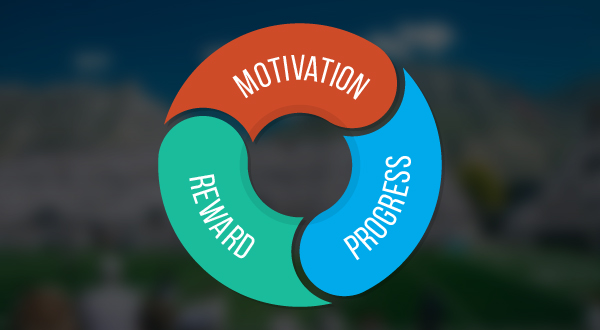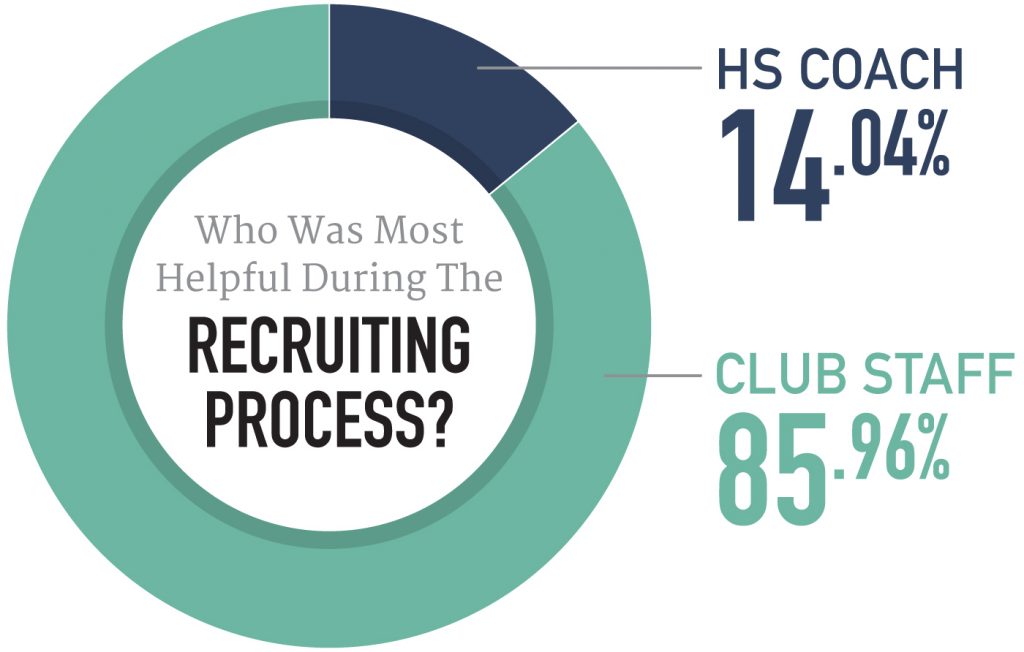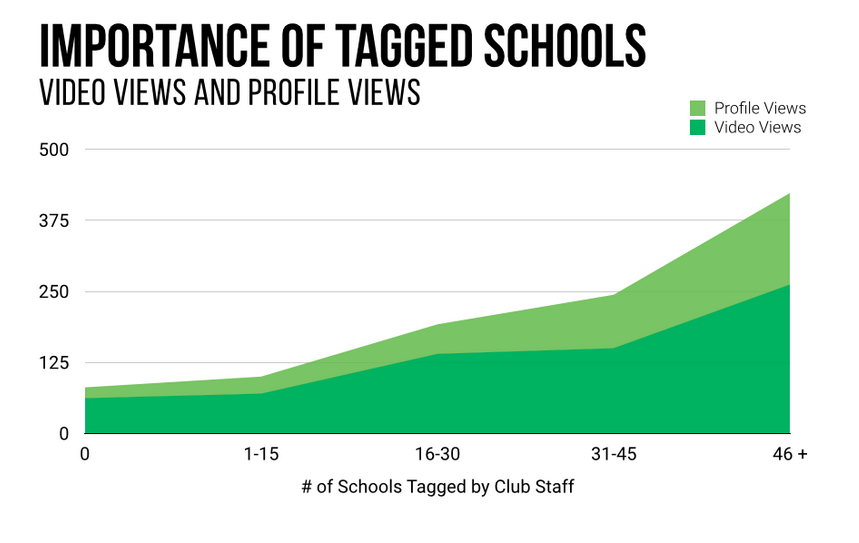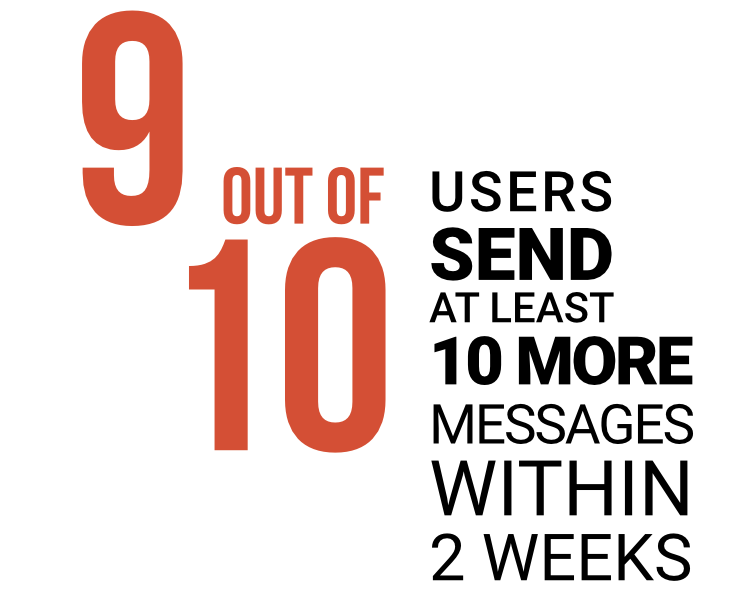Abstract
With the explosion of club teams, showcases and tournaments, families now more than ever are relying on their club’s staff for guidance in the recruiting process. However, this task can be very difficult, because student-athletes are often not motivated in the process until it reaches a critical stage. As such, it is vital for a club to have a blueprint that ensures student-athletes and their families are motivated and engaged from the beginning. This paper will discuss three ways in which a club can catalyze this motivation, thus helping to alleviate one of the largest pain points involved in the process.
Introduction
In a recent SportsRecruits survey, nearly 86% of respondents noted that more so than their high school coaches, club staff members were most helpful during their recruitment.
This is a significant number, and brings home a truism that has already existed in much of the youth sports space for a long time: The impact of a club on a student-athlete’s recruiting process is paramount.
As the reliance on club staffers has increased, the space itself has also grown, with new organizations at every turn attempting to meet the demands of a market desperate for an advantage when it comes to playing at the next level.
Combined, these factors have resulted in more players on more club teams asking for more help as it relates to recruiting. This presents quite a challenge, as clubs are often still using dated technologies and limited personnel to try to handle a burgeoning number of families. Club staffers often unintentionally end up in a reactive position, trying to handle recruiting needs as they arise in a triage fashion.
One of the underlying causes of this reactionary position is motivation: It is very difficult to provide assistance if the student-athlete is not willing to attack the process as well. So the question then becomes one of engagement: How do you get players to do the work needed on their end to make your assistance felt?
Based on empirical evidence from our platform, in conjunction with psychological research on the topic, here are three steps clubs can follow to ensure student-athletes and their families are motivated and engaged in the recruiting process, allowing the club’s position to become a proactive one while putting the student-athlete in control of their own future.
1. Show Small Signs of Progress
What to Do: One of the best ways to build positive momentum for a student-athlete is to provide them a structure for action, and then positive feedback when this roadmap is adhered to.
A way to do this is to first sit down with a student-athlete and create a finite list of “target schools,” places that would be a good fit in the academic, athletic and social realms. By doing this, you are providing a clear decree for further action: A student-athlete is more likely to contact these schools proactively because they are doing so with confidence, buoyed by the encouragement of an authority figure.
We came to this conclusion based on the empirical evidence from our platform, as charted in the graph above. The “Tagging” feature on our site allows a club staff member to go in and recommend schools for their student-athletes in a similar fashion as we just described.
The results indicate a direct, positive correlation between the staff involvement in this capacity and the number of messages sent by players to college coaches – ultimately resulting in the profile and video views from college coaches that the graph depicts.
As a player is alerted that a club staffer has recommended a school for them, it serves as a motivating factor to spur action. Student-athletes are more likely to act, because they are moving forward with confidence. Said another way, small signs of progress will catalyze engagement.
Whatever your club decides, having this clear roadmap, and ensuring your assistance is being tangibly relayed to a student-athlete and their family, can go a long way toward starting the process.
The Science: According to Teresa Amabile and Steven Kramer in the their work The Progress Principle: Using Small Wins to Ignite Joy, Engagement and Creativity at Work, simply seeing progress is a vital to success.
“We consider this to be a fundamental management principle: facilitating progress is the most effective way for managers to influence inner work life.”
They continue, “Small wins often had a surprisingly strong positive effect, and small losses a surprisingly strong negative one. We tested our impressions more rigorously in two ways. Each confirmed the power of progress to dominate inner work life.”
What It Means: This principle is fairly straight-forward: The more you see progress – even if it is something minor – the are more likely to continue to do something.
Using this principle, it can be said that by doing something as simple showing a player your involvement can act as a motivating factor to jump-start the rest of the recruiting process.
2. Rewards Mean More Consistent Engagement
What to Do: There is a fairly telling statistic from our data that shows once a student-athlete really engages in the process, they will continue to do so: 88% of users who send 10 messages to college coaches send at least 10 more in the next 2 weeks.
This is because sending a message and eliciting a response acts as a “reward,” or an impetus to continue on the same trajectory. At the club level, a reward can simply be email recognition or even skipping a conditioning drill.
The point is that a reward soon after a positive activity (in this case, a positive step in the recruiting process) will ultimately beget more activity, because scientifically our brain understands it will lead to a positive result.
The rewards of sending a message on our platform come in the form of a text message and email to student-athletes and their parents. When a college coach views a student-athlete’s profile or highlight reel, they are alerted immediately. This kind of immediate rewards system can have positive results.
Whatever the method, the important thing is that when it comes to motivation and engagement, small rewards can pay large dividends — ones that result in a pattern of continued engagement.
The Science: When used correctly, positive reinforcement can be very effective. While this is fairly common knowledge, it is still helpful to hear the science behind it.
According to Kendra Cherry of Psychology.com, “a behavioral guidelines checklist published by Utah State University shows positive reinforcement is most effective when it occurs immediately after a behavior. The guidelines also recommend the reinforcement should be presented enthusiastically and should occur frequently.”
What It Means: Again, this is a fairly straightforward and understood bit of science (thanks, Pavlov’s dog!).
However, recognizing that simple, quick positive feedback acts as a reward system can scientifically assist a club in driving motivation and engagement. As our numbers show, this engagement is not a one-off, but it begets further action down the line.
3. Competition Can Serve to Motivate Your Players
“The motivation to begin is the single-hardest step in the recruiting process, while simultaneously being the most important.”
What to Do: Competition is one way to encourage positive activity. In your club, it is very possible to create competition out of engagement in the recruiting process.
Getting a player to want to complete inside your organization in a meaningful way can help players get started by using peer pressure as a positive. Doing things like creating contests out of small steps in the recruiting process – such as getting a target list of schools together, or gathering pertinent recruiting materials – can result in a net positive across your club.
Not wanting to be left behind, players will begin to engage while simultaneously training the brain to want to continue down this road. Here is why.
The Science: While often accompanied by a negative connotation, numerous scientific studies have noted that peer pressure can often be used to lead to a positive result.
The scientific reasons boil down to something called “synaptic pruning,” a process which while complicated can be explained like this: The brain, in an effort to become more efficient, will redirect resources to active synapses in charge of decision making while ridding those not in use.
This may sound confusing (and it is), but it can be boiled down simply: The activities of a teenager can literally alter brain development. Positive activities, then, can lead to positive results (just as negatives can lead to negative ones – like the peer pressure to make a poor choice).
“The hardest part is the first step” is also something backed by science. Often, taking the first step is made difficult because the process seems too daunting, which allows negative thoughts to enter the brain, which in turn leads to procrastination. In the case of recruiting, procrastination simply means not actively starting to think about a target list of schools, events to attend and similar small activities.
According to Daniel Akst in Temptation, Finding Self-Control in the Age of Excess, “Procrastination is a mood-management technique…far and away the most procrastination occurred among the bad-mood students who believed their mood could be changed and who had access to fun distractions.”
What That Means: The motivation to begin is the single-hardest step in this process, while simultaneously being the most important. We can easily see why a student-athlete, who is trying to navigate their way through high school, may not be thinking too hard about their college destination. Simply put, it’s just too easy to not heed advice or prompts to meet a club staffer in the middle.
The distractions are endless – technology, social pressures and academics, for starters – and it can be very hard to get a student-athlete started early in a proactive manner that will begin to feed itself.
However, by embracing the ability of competition as a way to encourage positive activity, the seeds of not getting the recruiting process started will not be able to germinate into apathy.
Conclusion
Student-athletes and their families are increasingly relying on their club staffers for recruiting assistance. It can be very difficult to motivate and engage these players in their own processes, thus making it very difficult for a club to adequately assist these players and elicit a positive experience.
By utilizing the underlying scientific principles behind procrastination, motivation and continued action, clubs can better and more effectively serve their families.





